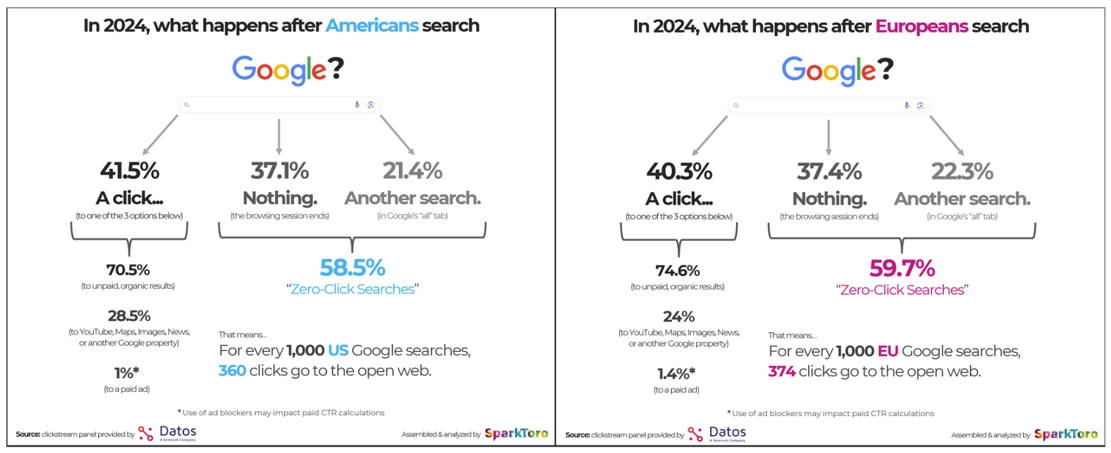SEO professionals are on the verge of a new era.
With hindsight, the previous epoch could be called “The Age of the One-Trick Pony.” It began back in 2002 when Google passed more than a dozen crawlers and directories to become the dominant search engine.
If you learned how to improve a website’s visibility in Google’s natural or unpaid search results, then you could get a respectable job as a search engine optimizer.
But, the era of one-trick ponies is about to end. So, it’s time to re-envision your career path.
Going forward, SEO specialists will need to invest more time in learning four additional disciplines: digital analytics, digital advertising, content marketing, and social media marketing.
SEO managers will also need to demonstrate critical thinking about digital marketing strategy if they ever hope to climb the ladder.
So, where should you begin?
Digital Analytics
You should start by learning more about digital analytics, which is the process of collecting, measuring, analyzing, and interpreting data from digital sources to understand how users interact with online content.
This will help you understand why traditional metrics like “keyword rankings” and “organic pageviews” – which are the top two performance metrics that SEO professionals use to measure success in 2024 – aren’t getting noticed anymore. This means they’re never going to help you get a promotion, let alone a seat at the big table.
As Search Engine Journal’s State Of SEO 2025 noted:
“Keyword rankings and pageviews are not necessarily relevant to business goals. They’re the main metrics being disrupted right now, but it’s critical to lean into disruption to discover opportunities and change strategies.”
So, it is worth learning how digital analytics can help you measure success using key performance indicators (KPIs) that are tied to business goals like “drive online sales” for ecommerce sites, “generate leads” for lead-generation sites, and even “raise brand awareness” for publishers.
For example, Rand Fishkin recently wrote a blog post titled, 2024 Zero-Click Search Study: For every 1,000 EU Google Searches, only 374 clicks go to the Open Web. In the US, it’s 360.
He used a clickstream panel from Datos to tackle a couple of critical questions:
- What typically occurs after Americans and Europeans perform a Google search?
- In 2024, what percentage of searches end without any clicks?
As the twin charts below indicate, close to 60% of Google searches result in zero clicks, while slightly more than 40% result in a click.
 Image from Sparktoro, September 2024
Image from Sparktoro, September 2024Of the searches that result in a click, about 25-30% go to platforms that Google owns, including YouTube, Google Images, Google Maps, and Google News. Meanwhile, the other 70% to 75% go to a non-Google-owned, non-Google-ad-paying property.
For every 1,000 Google searches, only 360 clicks in the U.S. and just 374 clicks in Europe go to the open web.
That is why you should use digital analytics to measure the impact of visibility in Google’s natural or unpaid search results on raising brand awareness.
How do you do that? As I mentioned in No-Click Searches Require A New Way To Measure SEO Results, this issue might be relatively new for SEO specialists and managers, but it’s a long-standing challenge for PR professionals.
In the late 1980s, I was the director of corporate communications at Lotus Development Corporation and at Ziff-Davis during the 1990s. Back then, I began utilizing surveys to measure the impact of publicity on brand awareness.
Today, you can use a modified version of brand lift surveys to measure this KPI.
Brand lift surveys ask people questions about your brand and products – either before and after your target audience has been exposed to a new campaign or at regular intervals.
The questions can help you understand how your SEO efforts and other cross-channel programs are impacting your brand, including:
- Awareness.
- Consideration.
- Favorability.
- Purchase intent.
In other words, learning to use digital analytics to measure, analyze, and interpret data is significantly more valuable to your career than just using the same old web analytics metrics that SEO pros have been collecting and reporting for more than 20 years.
Digital Advertising
Next, I would recommend learning more about digital advertising, which includes pay-per-click (PPC) advertising.
Digital ads can appear in many forms, including text, images, audio, and video, and can be found on various platforms, such as search engines, social media, and websites.
You’re probably sharing your keyword research with colleagues in your advertising department or over at your ad agency. But that is just the front end of a longer process – you should learn more about the middle and back end, too.
For example, I had bet dollars to donuts that your colleagues in advertising are busy setting up audiences in Google Analytics 4, which lets them segment users in ways that are important to your business.
By linking your GA4 account to Google Ads, they can remarket to them.
Why does this represent a strategic opportunity for SEO pros?
Back in December 2020, I wrote The Future Of SEO Lies In The ‘Messy Middle’ Of The Purchase Journey. I reported on research by Google’s Market Insights team in the UK, which found:
“People don’t make decisions in a neat, linear fashion.”
Between the moment they realize they need or want something and the moment they make a purchase, a lot happens.
The research also found:
“People look for information about a category’s products and brands, and then weigh all the options.”
They go through two different mental modes in the messy middle: exploration, which is an expansive activity, and evaluation, which is a reductive activity.
It concluded:
“Whatever a person is doing, across a huge array of online sources, such as search engines, social media, and review sites, can be classified into one of these two mental modes.”
So, how do SEO professionals harness this insight?
What if you started building “SEO audiences” in GA4 to help people in the “messy middle” of their purchase journey?
You could then share your SEO audiences with your colleague in advertising, who could then create a remarketing campaign targeted at this specific group of users – and help them complete their purchase journey.
For example, if your SEO program builds an audience of 1,000 users who:
- Begin the checkout process, then your colleague could use Google Ads to ask them to make a purchase.
- Download a white paper, then your colleague could use Google Ads to ask them to complete a registration form.
- Scroll to 90% of a blog post or article, then your colleague could use Google Ads to ask them to subscribe to a newsletter.
SEJ’s State of SEO 2025 says the biggest barrier to SEO success in the last 12 months was “budget and resources.” And that was followed by two other traditional barriers: “Google algorithm updates” and “competition in SERPs.”
But if you dig a little deeper, the fourth item on the list of the biggest barriers to SEO success was “alignment with other departments.”
So, imagine what would happen if the SEO and PPC people started working together to help people in the “messy middle” of their purchase journey?
Content Marketing, Social Media Marketing, And SEO
Speaking of alignment with other departments, SEO pros need to learn even more than they already know about content marketing and social media marketing.
Why? Because these three disciplines often overlap, as you can see in the illustration below, which appears in Digital Marketing Fundamentals: OMCP’s Official Guide to OMCA Certification. (Disclosure: I am one of the co-authors.)
 Image from author, September 2024
Image from author, September 2024Overlapping responsibilities can be a waste of time and frustrating for teams. So, these tend to be the first things that companies and clients trim when they tighten their purse strings.
Ironically, slightly overlapping roles can improve workflow integration. This is because each role’s activities impact the next process in the workflow.
Alignment with other departments isn’t just a way to keep your SEO budget and resources from being cut. It is also a way to overcome other barriers to SEO success, like “Google algorithm updates” and “competition in SERPs.”
Want an example?
Just read AI On Innovation: Analysis Of +546,000 AI Overviews.
The article by Kevin Indig dives into the latest data on AI Overviews (AIO) to understand domain visibility, citation trends, and effective search strategies crucial for SEO success.
What does he notice? The top three most cited domains in AIOs are:
- YouTube.com.
- Wikipedia.com.
- LinkedIn.com.
What does he wonder?
“The fact that two social networks, YouTube and LinkedIn, are in the top three most cited domains raises the question of whether we can influence AIO answers with content on YouTube and LinkedIn more than our own.”
Indig also notes that videos take more effort to produce than LinkedIn answers, but videos might also be more defensible against copycats. So, “AIO-optimization strategies should include social and video content.”
Let us imagine that you are the SEO manager at a Fortune 500 company. What would happen if your chief marketing officer (CMO) decided to create a task force to develop AIO-optimization strategies?
If the task force included managers from the SEO, content marketing, and social media marketing departments, then how likely is it that you would be selected to head up this team?
Unfortunately, your CMO has probably read The people who ruined the internet, which was published in The Verge on Nov. 1, 2023.
Since then, SEJ’s State of SEO 2025 confirms that 46.3% of SEO professionals are “content goblins,” a term that the author coined to describe people “willing to eschew rules, morals, and good taste in exchange for eyeballs and mountains of cash.”
Another 25.2% of SEO pros are “alligator wrestlers,” another term coined by The Verge to describe the link spammers who want people to click on “WATCH: 10-foot Gator Prepares to Maul Digital Marketers.”
And 19.6% were confused by these descriptions, which indicates that they don’t get out of their silos very often.
So, how do you avoid the stereotype that SEO pros are hustlers, while simultaneously demonstrating that you have the education, expertise, and experience needed to lead an interdisciplinary team?
Yes, you could cram for the job interview by reading 20 Confirmed Facts About YouTube’s Algorithm and LinkedIn Algorithm Change Could Promote Your Best Posts For Months.
But you’d probably improve your chances of getting the new position by also reading:
- A Beginner’s Guide To YouTube Marketing.
- Content Marketing: The Ultimate Beginner’s Guide.
- Consumer Usage Of Social Media Platforms Is Shifting (Again).
- How To Dominate Social Media Marketing: A Complete Strategy Guide.
In other words, the more you know about content marketing and social media marketing, the more likely it is that you will be chosen to head up a task force to develop AIO-optimization strategies.
And working collaboratively with other departments to leverage YouTube, LinkedIn, and cross-channel strategies will also increase your odds of getting promoted in the foreseeable future.
Digital Marketing Strategy
But when you climb the corporate ladder, don’t be surprised if your next job title doesn’t include the term “search engine optimization” or “SEO.”
Back in November 2020, I noticed that there were very few vice presidents of search engine optimization. And back then, I wondered what SEO managers still needed to learn to become a VP of SEO.
In February 2024, Adam Audette provided an update in a post titled, The Demise of the VP of SEO Role. He noticed:
“Over the last 18 months there has been a marked decline in the job market for senior SEO leadership roles across in-house and agency landscapes, and this trend is persisting.”
And he wondered:
“Maybe companies don’t believe SEO by itself is enough anymore. Job seekers need SEO plus something extra.”
As I mentioned earlier, the era of one-trick ponies is about to end. What comes next can only be described using Words of Estimative Probability (WEP), which are used by intelligence analysts in analytic reports to convey the likelihood of a future event occurring.
So, whether you’re called the VP of marketing, CMO, or chief growth officer (CGO), the challenge will be the same: Create successful digital marketing strategies when your global company or top brand is faced with unexpected opportunities or unanticipated threats in the unforeseeable future.
What are the odds that you can overcome that challenge?
You can increase the likelihood of success by reading case studies and then asking yourself two questions:
- What do I notice?
- What do I wonder?
I used this approach when I wrote the chapter on digital marketing strategy in the book, “Digital Marketing Fundamentals.” I shared two articles that I had written for Search Engine Journal:
- Kraft Heinz: Isn’t Anyone Going to Help That Poor Brand?
- Nostalgia Marketing & What We Can Learn From John Lewis Ads.
Now, learning lessons from others is a good start, but you can significantly improve your chances of success by borrowing a big idea from my old friend and former colleague, Avinash Kaushik. He wrote an article titled, Stop Exceeding Expectations, Suck Less First.
He said that we should stop trying to “exceed the (often less-than-optimally informed) expectations of Wall Street Analysts” because “this desire to overachieve also comes at a very heavy cost – it drives sub-optimal behavior.”
Instead, he recommended this “as the #1 goal for your company: Suck less, every day.”
How does this incremental approach help a VP of marketing, CMO, or CGO achieve their business objectives?
In the same chapter on digital marketing strategy, I referenced a post in Occam’s Razor by Kaushik titled, Digital Marketing And Analytics: Two Ladders For Magnificent Success.
Back in December 2013, he said:
“More often than not, magnificent success results from executing a business plan that is rooted in a strong understanding of the landscape of possibilities, and a deep self-awareness of business capabilities. These business plans will contain a structured approach…”
Then, he shared the Digital Marketing “Ladder of Awesomeness” below.
 Image from Occam’s Razor by Kaushik, September 2024
Image from Occam’s Razor by Kaushik, September 2024Next, Kaushik shared the Digital Analytics “Ladder of Awesomeness” below, which outlines the KPIs for each step.
 Image from Occam’s Razor by Kaushik, September 2024
Image from Occam’s Razor by Kaushik, September 2024Now, your twin ladders of awesomeness might look a little different than his because this is 2024 – not 2013.
And both digital marketing and digital analytics have evolved. But the step-by-step process that Kaushik outlined will help you make the hard choices that are the most relevant for your company or brand when it finds itself in an unexpected, unanticipated, or unforeseeable position.
So, the first step in this new era of SEO is developing digital marketing strategies that help you avoid the pitfalls, seize the opportunities, and climb the ladder of success.
In parallel, the second step should be learning how to measure incrementality, the conversions that would not have occurred without marketing influence.
Oh, it’s also smart to start climbing these twin ladders of awesomeness as quickly as you can.
Why? Because the clock is ticking.
According to Spencer Stuart’s most recent CMO Tenure Study, Fortune 500 CMOs had an average tenure of 4.2 years last year.
However, there are differences between diverse types of companies.
CMOs at B2B companies tend to stay in their roles for an average of 4.5 years; CMOs at B2C companies average 4.0 years; CMOs at the top 100 advertisers hand on to their jobs for just 3.1 years.
In the next couple of years, a significant percentage of CMO jobs are going to open suddenly. How likely is it that you’ll be ready to be interviewed for one of them?
Spencer Stuart also noticed that 34% of Fortune 500 CMOs lead functions in addition to marketing, such as communications. So, the “plus something extra” trend extends from the SEO manager level all the way up to the CMO level.
The Age Of Awesomeness
Take an expanded view of marketing leaders’ growing purview and start climbing the ladder as soon as humanly possible.
The only thing that’s left to do is coin a unique term for the new era we’re entering.
We could call it the “Age of Awesomeness” or the “Epoch of Twin Escalators.” But I’m open to other suggestions.
What have you noticed, and what have you wondered?
More resources:
- 20 Confirmed Facts About YouTube’s Algorithm
- Is AI Going To E-E-A-T Your Experience For Breakfast? The LinkedIn Example
- State Of SEO 2025
Featured Image: ImageFlow/Shutterstock





![AI Overviews: We Reverse-Engineered Them So You Don't Have To [+ What You Need To Do Next]](https://www.searchenginejournal.com/wp-content/uploads/2025/04/sidebar1x-455.png)